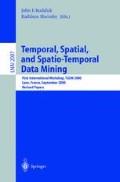Abstract
In this paper I define spatio-temporal regions as pairs consisting of a spatial and a temporal component and I define topological relations between them. Using the notion of rough sets I define approximations of spatio-temporal regions and relations between those approximations. Based on relations between approximated spatio-temporal regions configurations of spatio-temporal objects can be characterized even if only approximate descriptions of the objects forming them are available.
The financial support from the Canadian GEOID network is gratefully acknowledged.
Access this chapter
Tax calculation will be finalised at checkout
Purchases are for personal use only
Preview
Unable to display preview. Download preview PDF.
References
J.F. Allen. Maintaining knowledge about temporal intervals. Communications of the ACM, 26(11):832–843, 1983.
Peter Burrough and Andrew U. Frank, editors. Geographic Objects with Indeterminate Boundaries. GISDATA Series II. Taylor and Francis, London, 1995.
T. Bittner. On ontology and epistemology of rough location. In Spatial information theory-Cognitive and computational foundations of geographic information science, COSIT 99, number 1661 in Lecture Notes in Computer Science, Hamburg, Germany, 1999. Springer Verlag.
T. Bittner. Approximate temporal reasoning. In Workshop proceedings of the Seventeenth National Conference on Artificial Intelligence, AAAI 2000, 2000.
T. Bittner. A Haskell program generating all possible relations between boundary insensitive approximations of time intervals. http://www.cs.queensu.ca/?bittner, 2000.
[BNSNT+95]_J. Bazan, H. Nguyen Son, T. Nguyen Trung, A. Skowron, and J. Stepaniuk. Application of modal logics and rough sets for classifying objects. In M. De Glas and Z. Pawlak, editors, Proceedings of the Second World Conference on Fundamentals of Artificial Intelligence (WOCFAI’95), pages 15–26, Paris, 1995.
T. Bittner and J. G. Stell. A boundary-sensitive approach to qualitative location. Annals of Mathematics and Artificial Intelligence, 24:93–114, 1998.
T. Bittner and J. Stell. Rough sets in approximate spatial reasoning. In Proceedings of the Second International Conference on Rough Sets and Current Trends in Computing (RSCTC’2000). Springer Verlag, 2000.
R. Casati and A. Varzi. The structure of spatial localization. Philosophical Studies, 82(2):205–239, 1995.
Max J. Egenhofer and Robert D. Franzosa. Point-set topological spatial relations. International Journal of Geographical Information Systems, 5(2):161–174, 1991.
M. J. Egenhofer, D.M. Flewelling, and R.K. Goyal. Assessment of scene similarity. Technical report, University of Maine, Department of Spatial Information Science and Engineering, 1997.
P. Geach. Some problems about time. Proceedings of the British Academy, 11, 1966.
J. Glasgow, S. Fortier, and F.H. Allen. Molecular scene analysis: Crystal structure determination through imagery. In L. Hunter, editor, Artificial Intelligence and Molecular Biology. AAAI/MIT Press, 1993.
T.Y. Lin and N. Cercone, editors. Rough Sets and Data Mining. Analysis of Imprecise Data. Kluwer Academic Publishers, Boston, Dordrecht, 1997.
T.Y. Lin, editor. Proceedings of the Workshop on Rough Sets and Data Mining at 23rd Annual Computer Science Conference, Nashville, Tenessee, 1995.
R. Nowicki, Slowinski, and J. R., Stefanowski. Rough sets analysis of diagnostic capacity of vibroacoustic symptoms. Journal of Computers and Mathematics with Applications, 1992.
Z. Pawlak. Rough sets. Internat. J. Comput. Inform, 11:341–356, 1982.
D. A. Randell, Z. Cui, and A. G. Cohn. A spatial logic based on regions and connection. In 3rd Int. Conference on Knowledge Representation and Reasoning. Boston, 1992.
P. Simons. Parts, A Study in Ontology. Clarendon Press, Oxford, 1987.
B. Smith and A. Varzi. Fiat and bona fide boundaries: Towards an ontology of spatially extended objects. In S. Hirtle and A. Frank, editors, Spatial Information TheoryA Theoretical Basis for GIS, International Conference COSIT’ 97, Laurel Highlands, PA, volume 1329 of Lecture Notes in Computer Science, pages 103–119. Springer-Verlag, Berlin, 1997.
Simon Thompson. Haskell: The Craft of Functional Programming. Addison-Wesley, 2 edition, 1999.
Author information
Authors and Affiliations
Editor information
Editors and Affiliations
Rights and permissions
Copyright information
© 2001 Springer-Verlag Berlin Heidelberg
About this paper
Cite this paper
Bittner, T. (2001). Rough Sets in Spatio-temporal Data Mining. In: Roddick, J.F., Hornsby, K. (eds) Temporal, Spatial, and Spatio-Temporal Data Mining. TSDM 2000. Lecture Notes in Computer Science(), vol 2007. Springer, Berlin, Heidelberg. https://doi.org/10.1007/3-540-45244-3_8
Download citation
DOI: https://doi.org/10.1007/3-540-45244-3_8
Published:
Publisher Name: Springer, Berlin, Heidelberg
Print ISBN: 978-3-540-41773-6
Online ISBN: 978-3-540-45244-7
eBook Packages: Springer Book Archive

